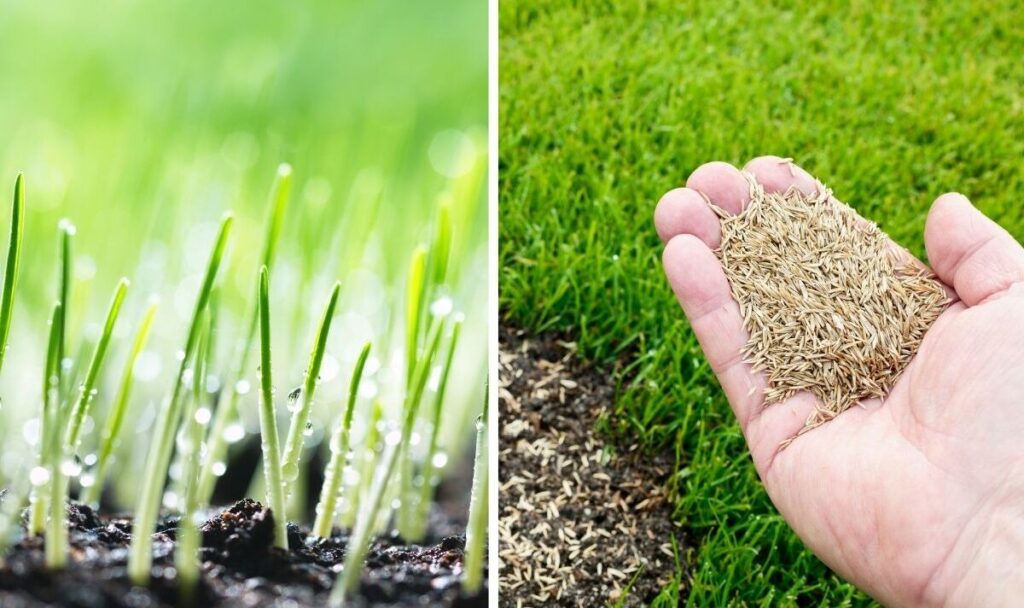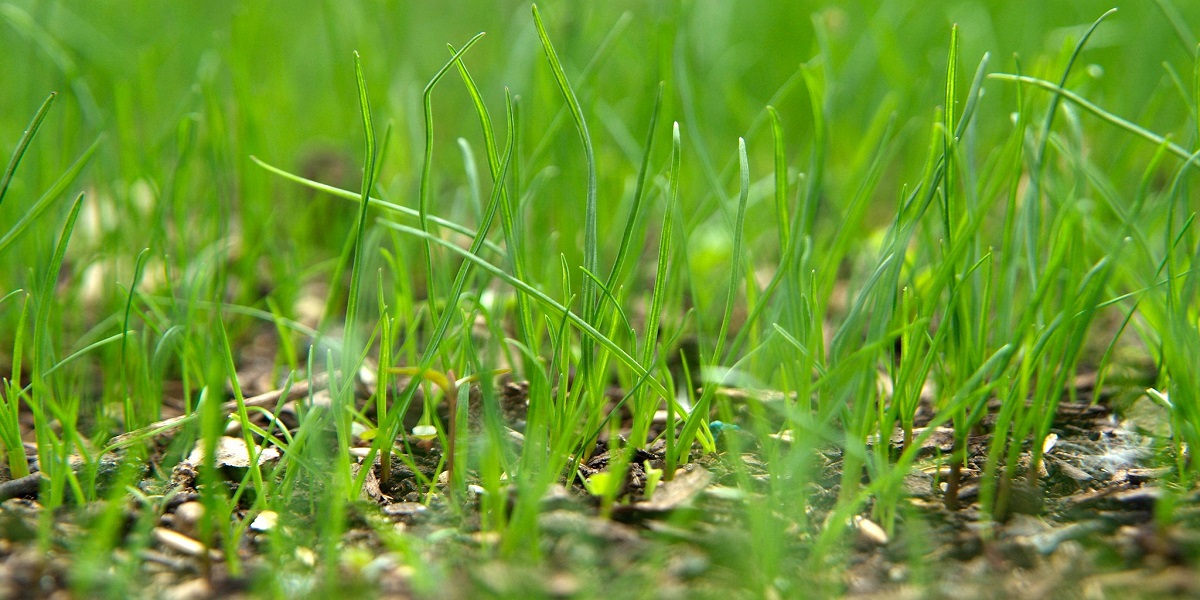How Long Does Grass Seed Take To Grow?
The grass is a very important element of our rural and urban lawns. Grass belongs to a family of the Poaceae or Graminae family. This family has many monocotyledonous flowering plants, and they are called Grass. It has thin, sharp, green leaves that overspread the whole ground.
Natural grass has multiple benefits; it is very beneficial for our environment. Just like all living plants, grass absorbs carbon dioxide and releases oxygen. Grass also cleans the air for us. Every year grass absorbs 12 million tons of carbon dioxide. More grass in an environment means more clean air to breathe.
Today, we will talk about how long does grass seed take to grow. So, let’s delve into this question.
What is a grass seed?

The seeds used to grow grass are grass seeds. They are mostly in light tan; depending on their variety and are different in size, quarter an inch to three quarters. Grass seeds have different types; understanding each type lets you know which type will be best for your lawn.
1. Bermuda grass seed:
This is most popular in the Southern U.S., a warm season grass. Cynodon Dactylon is the official scientific name of Bermuda grass.This seed grows grass in home lawns, golf courses, and football and baseball fields. It requires full sunlight to grow and can survive easily with just one inch of water per week. The growth rate of this grass is faster than any other grass.
2. Bahia grass seed:
Bahia grass is also warm-season grass that originated from South America and Mexico. Scientifically, it is known as Paspalum Notatum. It can be grown in any type of soil like sandy or poor-nutrient soil; any other type of grass can not survive in such soil. it transforms into V-shaped grass if it is not taken care of and trimmed properly. This grass type is super strong; it can also bear heavy traffic.
3. Zoysia grass seed:
Zoysia grass seed is also a popular type of grass. It is best for planters who are lazy in maintenance. Because it does not require persistent watering and fertilization, it grows in transition areas of the U.S. This area lies between the north and south. In transition areas, temperature changes and can make it difficult for grass to grow. This grass has a fine texture and is soft to the touch.
4. Fine fescue grass seeds:
It is a cold-season grass, also common for lawns. Fine fescue is a blend of different seeds; some common types are sheep fescue, chewing fescue, creeping red fescue, and hard fescue. Fine fescue can be differentiated by its soft and fine leaves. It can grow very easily in areas where sunlight is not too bright. Even bright and direct sunlight can cause harm to its growth and lifespan.
5. Perennial ryegrass seed:
This is also cold-season grass; among all grass seeds, it is the fastest-growing grass. Its features include thin and glossy leaves and dark green color. This grass can also be grown from scattered lawn seeds; it can grow in just 21 days. During the summer season, the grass starts to grow, then mostly vanishes and passes away.
How long does grass seed take to grow?
The growth of grass seeds relies on different factors, such as weather and soil conditions, grass species, and time of the year. After sowing, it takes almost 8-10 days to grow in optimum conditions. After 6-8 weeks of sowing, it grows fully and covers the entire lawn.
Now, you can enjoy it on your grass, play, walk, sleep, and jump. Knowing the growth of grass time will help you schedule your activities accordingly. It will grow continuously ⅔ cm per week, and you must trim it.
Which season is best to grow your grass?
Grass will grow differently in different seasons. Every season has a different impact on its growth. Also, its growth relies on the type of seed we sow. Blending your summer-season grass with winter-season grass can give your lawn a beautiful look for the whole year.
Here we will see separately which season is best for grass to grow. and how long does grass seed take to grow.
1. Winter season grass:
The grass we grow in the winter season is the fastest-growing grass. The optimum temperature of the soil to grow grass seeds is between 50 and 65 degrees Fahrenheit. With proper care and management it can fully grow in just 30 days. Winter season grass seeds should be planted in the middle of the winter when the cool temperature becomes high and stable. So that the grass can be fully nourished and the lawn can become ready before the summer season. Here are some best seed germination times for different popular seeds:
- Perennial ryegrass seeds: It require almost 5 to 10 days to germinate
- Tall fescue seeds: These require 7 to 12 days to flourish
- Kentucky bluegrass seeds: These require 7 to 10 days to develop fully
2. Warm season grass:
This season grass grows slowly compared to the winter season; it takes a longer time for root development and germination. Warm-season grass requires hot temperatures to grow; it needs temperatures between 60 and 75 degrees Fahrenheit. These grasses grow very tall in two months and can be trimmed easily, while full dense development takes more than a year. The seeds of summer season grass should be planted in spring to fully develop before the cool breezes of winter start blowing. Some frequently used grass seeds with their germination time are given below:
Bermuda grass seeds: take 10 to 30 days to germinate
- Zoysia grass seeds: it requires 14 to 21 days to flourish
- Centipede grass seeds: it also takes 14 to 21 days to flourish
- Buffalo grass seeds: it takes 14 to 30 days to develop
The speed of your grass growth entirely depends on some elements, and the most important is the type of grass seed you are planting. Ground preparation, age of the seed, time of the year, sunlight, and irrigation all play a major role in the development of grass and how quickly it grows.
Factors that help in the growth of grass seed:
The following factors will help in growing grass seeds faster:
1. Soil conditions:
Soil pH greatly affects how quickly a grass will grow. If you are planting grass seeds in winter, then soil pH should range from 6.0 to 7.2. Water your soil for a few days before planting your seed.Six to eight inches of soil should be soaked in water. After plantation, water your soil 2 to 3 times a day. Don’t forget to look for ground pests. These mini creatures can slow down the growth of grass. Protect your ground from these harmful and hungry bugs.
2. Weather:
Weather greatly affects the time grass takes to grow. The factor that can affect its growth is a temperature that is cooler than normal and an excessive water supply due to spring rains. We can’t control these natural occurrences. But you can check weather predictions to take precautionary measures and avoid such bad events. Plantation of seeds when temperatures are 60 to 75 degrees Fahrenheit can be beneficial.
3. A mixture of grass seeds:
Planters often blend different species of grass seeds to grow them faster. They blend perennial ryegrass seeds and fescues seeds. It makes grass grow with a soft texture. They use a ratio of 80% perennial ryegrass seeds and 20% fescue.
4. Water seeds consistently:
Watering your grass seeds is the most important factor. From the day you plant the seeds, water them daily. At this stage, your aim is to keep your ground moist. There should not be surplus water. You must water two or four times daily, depending on the soil conditions.
After the germination of grass seed, you must decrease the frequency of the water and increase the duration of the water supply. There are several ways to do this:
- From day 1 to Day 14, water grass seeds four times a day for 15 minutes
- Day 15 to Day 21, water 30 minutes one time daily
- Day 22 to 28, on alternate days, water 40 minutes one time
- Day 29 and above, water 45 minutes thrice a week
Conclusion:
Grass plays an important role in improving our environment and making our air clean. Also, grass helps to make our environment cool and gives an alluring view to our garden or lawn. Growing grass is important, and as responsible citizens, we must participate in this activity because it will be beneficial for everyone, not only for us.
Now its very clear that how long does grass seed take to grow and It is easy to grow grass by yourself; you just need to take care of some important things in this regard. Like we should take care of perfect weather and soil conditions. Also, the type of seed we select to grow matters a lot. Each type of seed has different requirements. And we need to take care of it according to its type. This activity can be more fun and captivating if you will do this with your homies.
Read More: HOW TO MAKE A WILDFLOWER MEADOW



